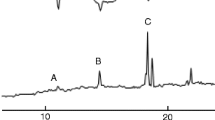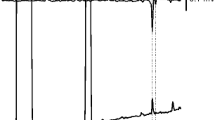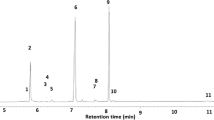Abstract
The male marking pheromone blends which emanate from the cephalic part of the labial gland, have been analyzed in four species of the bumble bee genusAlpinobombus, viz.,A. alpinus,A. balteatus, A. hyperboreus, andA. polaris, by combined capillary gas chromatography, mass spectrometry, and thin-layer chromatography. In all, 36 specimens were analyzed.A. alpinus andA. polaris, which are similar morphologically, both showed an acetogenic composition of the pheromone blend. The dominant compound inA. alpinus proved to be a hexadecenol, whereasA. polaris had a hexadecadienol and a hexadecenol in the proportions 5∶2 as major components.A. balteatus andA. hyperboreus, another species pair as regards their morphology, differed more in their chemical makeup. Both mevalogenins and acetogenins were found in their marking secretions.A. balteatus is unique among all other male bumble bee species analyzed, 29 in total, by having C12- and C14-butyrates in the secretion, which dominated together with tetradecyl acetate and geranylcitronellol. InA. hyperboreus the main marking compounds are an octadecenol and 2,3-dihydro-6-trans-farnesol. This species also contains citronellol and geranylcitronellol.
Similar content being viewed by others
References
Ahlquist, L., andStällberg-Stenhagen, S., 1971. Synthesis of (+)-and (−)-3,7,1 l-trimethyl-6-trnns-10-dodecadien-l-ol.Acta Chem. Scand. 25:1685–1694.
Alcock, J., 1975. Male mating strategies of some Philanthine wasps (Hymenoptera: Sphecidae).J. Kam. Entomol. Soc. 48:532–545.
Bergström, G., 1973. Use of a pre-column tube for the quantitative isolation of natural, volatile compounds for gas chromatography/mass spectrometry.Chem. Scr. 4:135–138.
Bergström, G., Kullenberg, B., andStällberg-Stenhagen, S., 1973. Recognition of two forms ofBombus lucorum L. (Hymenoptera, Apidae) by analysis of the volatile marking secretion from individual males.Chem. Scr. 4:174–182.
Bergström, G., andSvensson, B.G., 1973a. Characteristic marking secretion of the formslapponicus andscandinavicus ofBombus lapponicus Fabr. (Hymenoptera, Apidae).Chem. Scr. 4:231–238.
Bergström, G., andSvensson, B.G., 1973b. 2,3-Dihydro-6-trans-farnesol: Main component in the cephalic marker secretion ofBombus jonellus K. (Hym., Apidae) malesZoon Suppl. 1:61–65.
Bringer, B., 1973. Territorial flight of bumble-bee males in coniferous forest on the northernmost part of the island of Öland.Zoon Suppl. 1:15–22.
Calam, D.H., 1969. Species-and sex-specific compounds from the heads of male bumblebees (Bombus spp.).Nature 221:856–857.
Cederberg, B. 1977. Chemical defence in bumble bees.Proc. 8th Int. Congr. I. U.S.S.I. 1977:77.
Darwin, C. 1886. Über die Wege der Hummelmännchen, pp. 84–88,in E. Krause, (ed.). Gesammelte Schriften von Charles Darwin, Vol. 2. Leipzig.
Frank, A., 1941. Eigenartige Flugbahnen bei Hummelmännchen.Z. Vgl. Physiol. 28:467–484.
Franklin, H.J., 1912. The Bombidae of the New World.Trans. Am. Entomol. Soc. 38:177–486.
Free, J.B., 1971. Stimuli eliciting malting behaviour of bumblebee (Bombus pratorum L.) males.Behaviour 25:55–61.
Haas, A., 1946. Neue Beobachtungen zum Problem der Flugbahnen bei Hummelmännchen.Z. Naturforsch. 1:596–600.
Haas, A., 1949. Arttypische Flugbahnen von Hummelmännchern.Z. Vgl. Physiol. 31:281–307.
Haas, A. 1968. Vergleichende Verhaltungsstudien zum Paarungsschwarm der Hummeln (Bombus) und Schmarotzerhummeln (Psithyrus) I. Teil.Z. Tierpsychol. 24:257–277.
Hultén, E., 1971. Atlas of the Distribution of Vascular Plants in Northwestern Europe. Generalstabs. Lit. anst. förlag, Stockholm. 531 pp.
Krüger, E., 1951. Über die Bahnfluge der Männchen der GattungenBombus undPsithyrus.Z. Tierpsychol. 8:61–75.
Kullenbehg, B., 1956. Field experiments with chemical attractants on aculeate Hymenoptera males.Zool. Bidr. Upps. 31:253–352.
Kullenberg, B., 1973, Field experiments with chemical sexual attractants on Aculeate Hymenoptera males. II.Zoon Suppl. 1:31–41.
Kullenberg, B., 1975. Chemical signals in the biocoenosis, pp. 73–85,in G. Regneil (ed.).Biological Signals, Kungl. Fys. Sällsk., Lund.
Kullenberg, B., Berström, G., andStällberg-Stenhagen, S., 1970. Volatile components of the marking secretion of male bumble-bees.Acta Chem. Scand. 24:1481–1482.
Kullenberg, B., Bergström, G., Bringer, B., Carlberg, B., andCederberg, B., 1973. Observations on scent marking byBombus Latr. andPsithyrus Lep. males (Hym., Apidae) and localization of site of production of the secretion.Zool Suppl. 1:23–30.
Løken, A., 1973. Studies on Scandinavian bumble bees.Nor. Entomol. Tidskr. 20:1–218.
Milliron, H.E., 1973. A. monograph of the western hemisphere bumblebees (Hymenoptera: Apidae; Bombinae). II. The genusMegabombus subgenusMegabombus.Mem. Entomol. Soc. Can. 89:81–237.
Minks, A.K., Roelofs, W.L., Ritter, F.J., andPersoons, C.J., 1973. Reproductive isolation of two Tortricid moth species by different ratios of a two-component sex attractant.Science 180:1073–1074.
Pittioni, B., 1938. Neue und wenig bekannte Hummeln der Paläarktis (Hymenopot., Apidae).Konowia 17:244–263.
Pittioni, B., 1942. Die boreoalpinen Hummeln und Schmarotzerhummeln (Hymen., Apidae., Bombinae). I.Mitt. K. Naturwiss. Inst. Sofia 15:155–218.
Plath, O.E., 1934.Bumblebees and Their Ways. Macmillan, New York.
Richards, O.W., 1931. Some notes on the bumble-bees allied to Bombus alpinus L.Tromsö Mus. Årsh. 50 (1927) (6): 1–32.
Richars, K.W., 1973. Biology ofBombus polaris Curtis andB. hyperboreus Schönherrat Lake Hazen, Northwest Territories (Hymenoptera: Bombini).Quaest. Entomol. 9:115–157.
Sakagami, S.F., 1976. Specific differences in the bionomic characters of bumblebees. A comparative study.J. Fac. Sci. Hokkaido Univ., Ser., VI, Zool. 20(3):390–447.
Schremmer, F., 1972. Beobachtungen zum Paarungsverhalten der Männchen vonBombus confusus Schenck.Z. Tierpsychol. 31:503–512.
Skorikov, A.S., 1937. Die grönländischen Hummeln im Aspecte der Zirkumpolarfauna.Entomol. Medd. 20:37–64.
Stenhagen, E., Ställberg-Stenhagen, S., andBergström, G., 1973. Analytical techniques in pheromone studies.Zool Suppl. 1:77–82.
Stiles, E.W., 1976. Comparison of male bumblebee flight paths: Temperate and tropical (Hymenoptera: Apoidea).J. Kans. Entomol. Soc. 49:266–274.
StÄllberg-Stenhagen, S., 1972. Splitter-free all glass intake system for glass capillary gas chromatography of volatile compounds from biological material.Chem. Scr. 2:97–100.
Svensson, B.G., 1973. Morphological studies on the two Scandinavian subspecies ofBombus lapponicus Fabricius (Hym., Apidae).Entomol. Tidskr. 94:140–147.
Svensson, B.G., 1977a. Pheromones in male bumblebees—a taxonomical tool, exemplified byPyrobombus lapponicus Fabr. (Hym., Apidae).Proc. 8th Int. Congr. I. U.S.S.I. 1977:317.
Svensson, B.G., 1977b. Behavior and volatile marking substances as isolation mechanisms in male bumblebees.Kaskelot 31:13–15 (in Danish).
Svensson, B.G., 1978.Pyrobombus lapponicus auct. in Europe recognized as two species:P. lapponicus (Fabricius 1793) andP. monticola (Smith 1849) (Hymenoptera, Apoidea, Bombinae).Entomol. Scand. (in press).
Svensson, B.G., andBergström, G., 1977. Volatile marking secretions from the labial gland of North European Pyrobombus D.T. males (Hymenoptera, Apidae).Insect. Soc. 24:213–224.
Svensson, B.G., andLundberg, H., 1977. Distribution of bumble bee nests in a subalpine/alpine area as reference to altitude and habitat. (Hym., Apidae).Zoon 5:63–72.
Tengö, J., andBerström, G., 1976. Odor correspondence betweenMelitta females and males of their nest parasiteNomada flavopicta K. (Hymenoptera: Apoidea).J. Chem. Ecol. 2:57–65.
Tkalců, B., 1972. Arguments contre l'interprétation traditionelle de la phylogénie des abeilles (Hymenoptera, Apoidea). Première partie introduction at exposés fondamentaux.Bull. Soc. Entomol. Mulhouse. 17–28.
Tkalců, B., 1974. Beitrag zur kenntnis der Hummelfauna der Französischen Basses-Alpes (Hymenoptera. Apoidea. Bombinae).Ac. Rer. Natur. Mus. Nat. Slov. Bratislava 20:167–186.
Velthius, H.H.W., andde Camargo, J.M.F., 1975. Observations on male territories in a carpenter bee,Xylocopa (=Neoxyhcopa)hirsutissima Maidl. (Hymenoptera, Anthophoridae).Z. Tierpsychol. 38:409–418.
Author information
Authors and Affiliations
Additional information
Hymenoptera, Apoidea, Bombinae.
Rights and permissions
About this article
Cite this article
Svensson, B.G., Bergström, G. Marking pheromones ofAlpinobombus males. J Chem Ecol 5, 603–615 (1979). https://doi.org/10.1007/BF00987845
Received:
Revised:
Issue Date:
DOI: https://doi.org/10.1007/BF00987845




